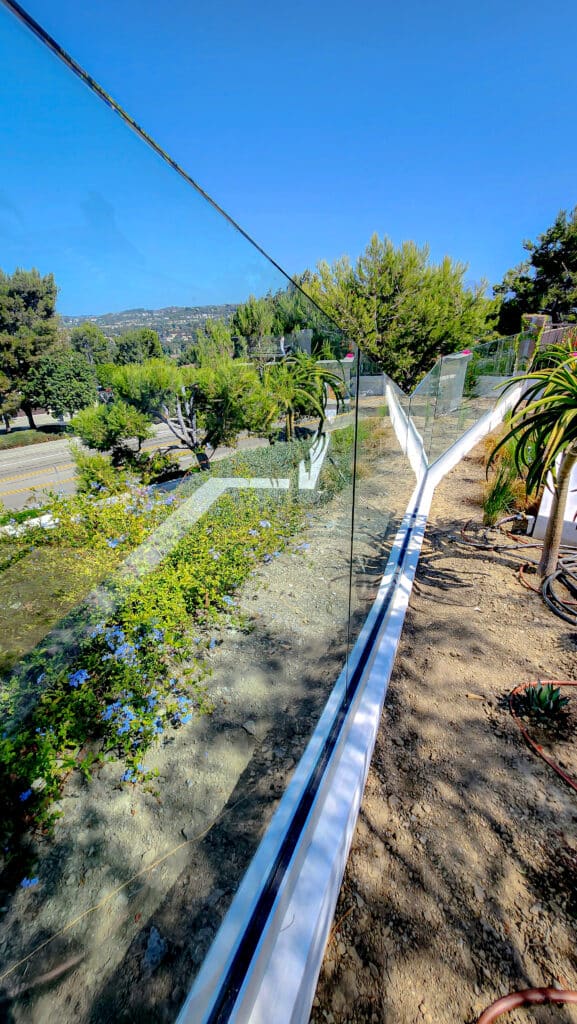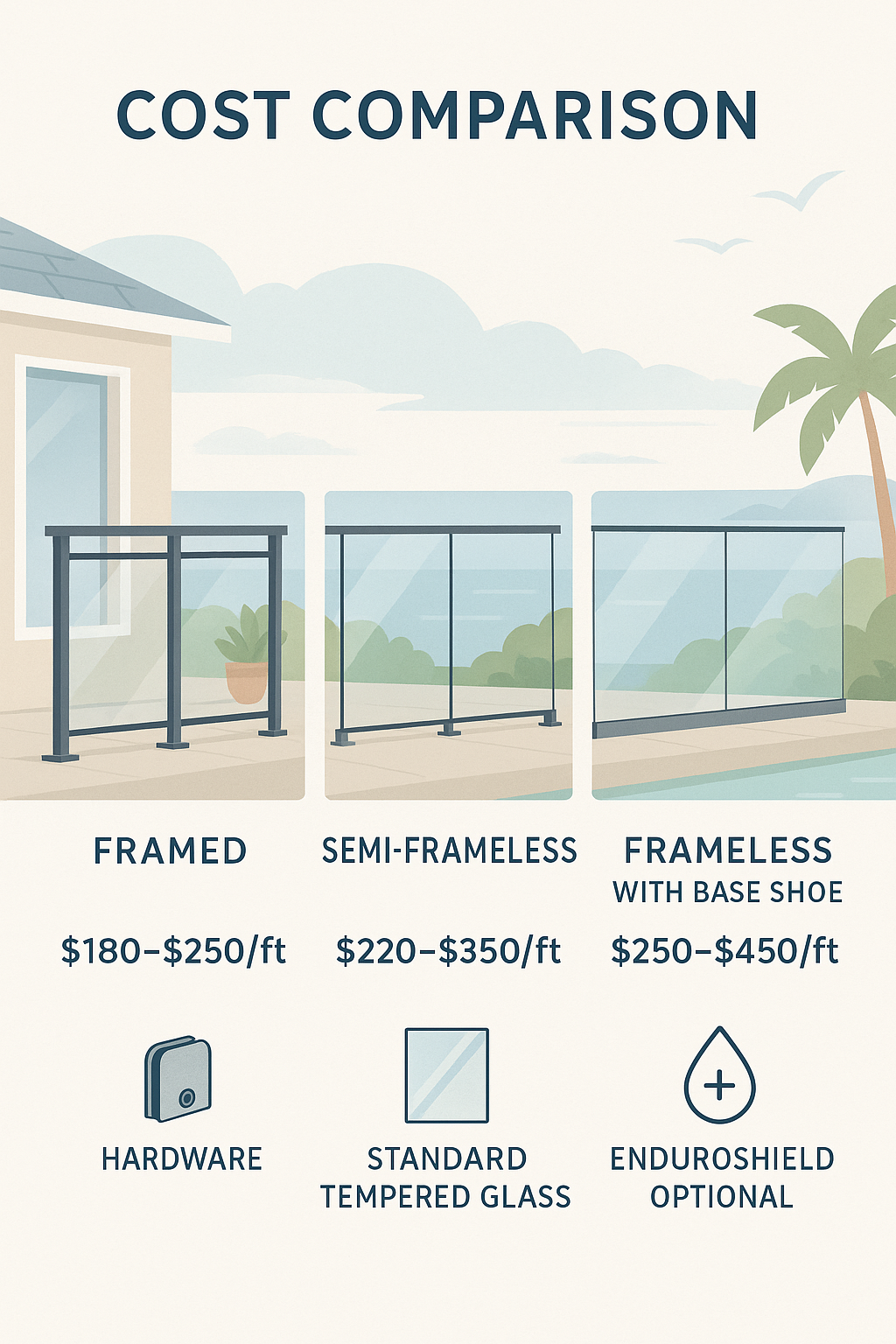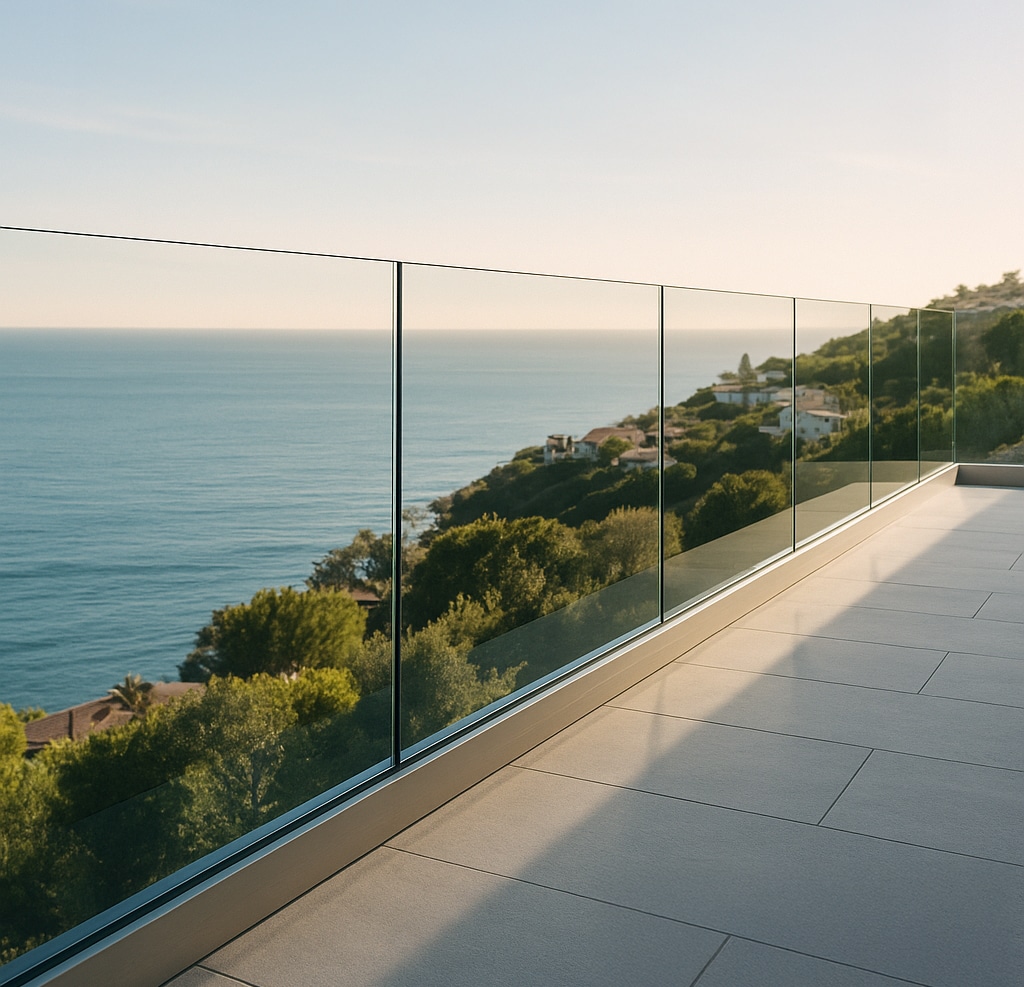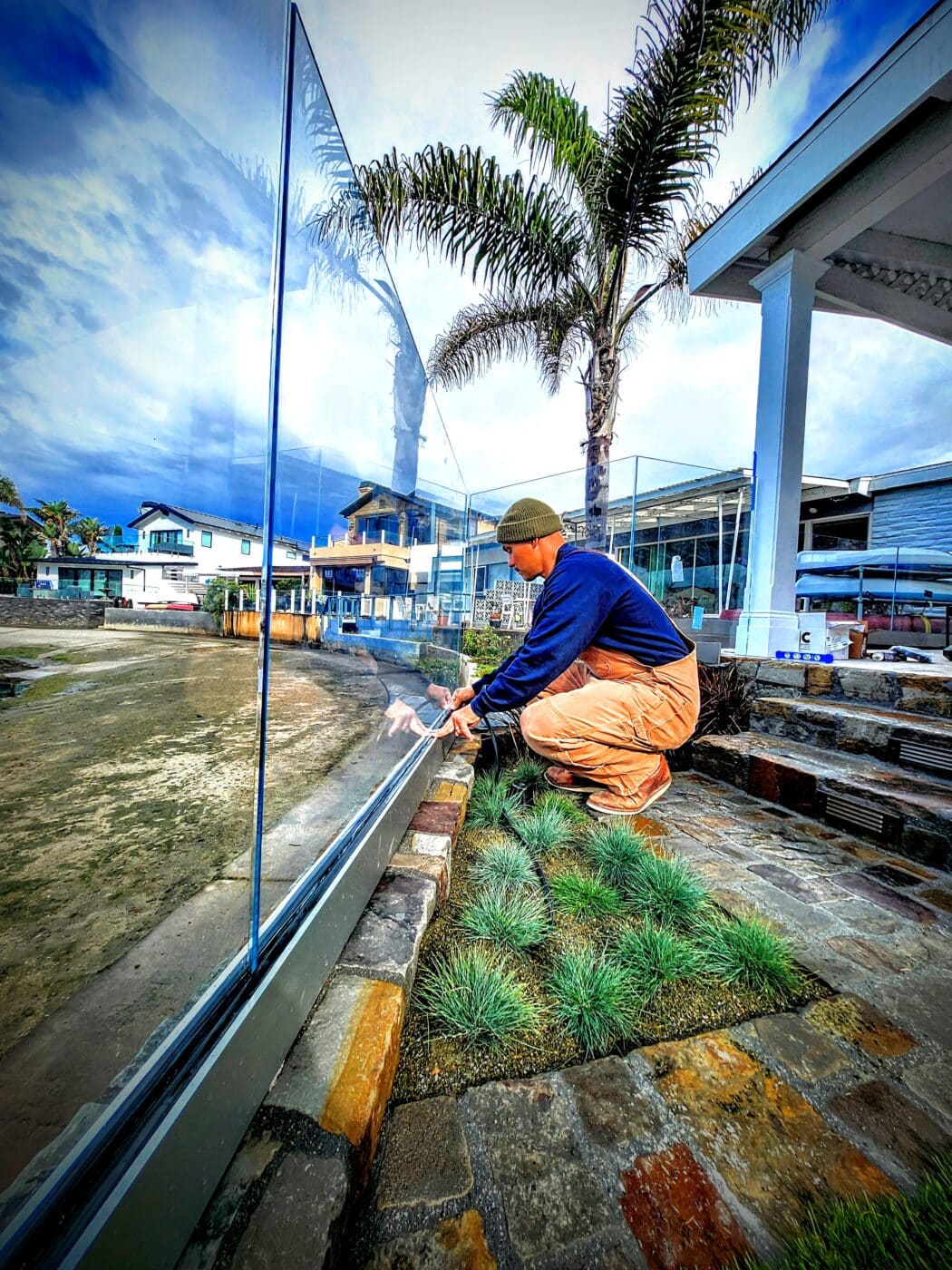Section 1: Introduction
Glass railings have become increasingly popular in modern architecture due to their elegant appearance, minimal visual obstruction, and versatility. Especially favored in Orange County, California, these railings perfectly complement the region’s contemporary home designs, scenic coastal views, and luxurious outdoor living spaces.
Homeowners in Orange County appreciate glass railings for their ability to seamlessly blend indoor and outdoor environments, making spaces feel larger and brighter. Whether installed around balconies, decks, staircases, or pool enclosures, glass railings provide unobstructed sightlines and safety without compromising aesthetics.
This blog post explores the different glass railing options available in Orange County, current design trends, essential building code requirements, and tips for selecting the best products and installers.
What You’ll Learn in This Guide:
- Different types of glass railing systems and their benefits.
- Design styles popular among Orange County homeowners.
- Critical safety codes and standards applicable to Orange County, including the California Building Code (CBC).
- Cost considerations, including factors that impact your budget.
- Practical advice for maintenance, ensuring your glass railings remain pristine and durable.
Whether you’re upgrading your existing home, building a new property, or planning a commercial project, this guide will equip you with the insights to confidently choose the perfect glass railing system for your needs.

Section 2: Types of Glass Railings
When selecting glass railings for your home or commercial project in Orange County, understanding the available styles and their benefits is essential. Here are the three primary types of glass railing systems:
1. Frameless Glass Railings
Frameless glass railings offer the cleanest, most minimalist appearance, making them particularly popular for properties in coastal and contemporary settings. They’re installed without visible frames or vertical posts, providing completely unobstructed views of surrounding landscapes, ocean horizons, or pool areas. Typically, frameless railings rely on robust, low-profile base shoe mounting systems for secure attachment.
Benefits:
- Maximum visual transparency
- Contemporary, upscale aesthetic
- Enhances property value due to premium appearance
2. Semi-Frameless Glass Railings
Semi-frameless railings blend the openness of frameless designs with the added structural stability and visual interest provided by minimalistic framing. These railings often feature sleek vertical posts and occasionally a subtle top rail. Semi-frameless systems are ideal when homeowners want modern elegance with a touch more definition.
Benefits:
- Combines transparency and structural stability
- Slightly lower cost compared to fully frameless systems
- Versatile design compatible with various architectural styles
3. Framed Glass Railings
Framed glass railings incorporate vertical posts and clearly visible top and bottom rails, usually constructed from aluminum or stainless steel. This type is a popular choice for traditional or transitional home designs, offering excellent safety and durability, along with cost efficiency.
Benefits:
- Most affordable of the three options
- Easy to install and maintain
- Sturdy construction suitable for high-traffic areas and commercial applications
Key Considerations:
- Frameless systems typically use thicker glass (usually ½-inch tempered) due to their reliance solely on base mounting systems for structural integrity.
- Semi-frameless and framed options may utilize slightly thinner glass and can offer greater cost-effectiveness, depending on hardware selection.
Understanding these differences helps ensure that the railing style you choose aligns perfectly with your property’s aesthetic and practical requirements.
Section 3: Popular Design Styles and Trends in Orange County
Orange County is well-known for its beautiful coastline, luxurious homes, and refined architectural tastes. Glass railings have become a cornerstone of modern design in the area, perfectly complementing local aesthetics. Here are three popular glass railing design trends currently thriving in Orange County:
1. Contemporary Minimalism
Characterized by clean lines, sleek materials, and open spaces, contemporary minimalism is highly sought after in Orange County, particularly in areas like Newport Beach, Laguna Beach, and Dana Point. Frameless or semi-frameless glass railings blend effortlessly into these modern environments, enhancing the sense of space and maximizing panoramic views.
Ideal For:
- Modern homes with minimalist interiors
- High-end oceanfront properties
- Rooftop decks and open floor plans
2. Coastal Style
The coastal style embraces natural textures, soft colors, and open, airy spaces that reflect Orange County’s seaside charm. Glass railings in coastal homes typically combine frameless or semi-frameless glass with brushed stainless steel or powder-coated aluminum in neutral shades, complementing weathered wood accents and soft coastal palettes.
Ideal For:
- Beachfront or near-coast residences
- Homes designed with natural, relaxed aesthetics
- Properties in areas such as Corona Del Mar, San Clemente, and Huntington Beach

3. Luxury and Custom Options
For upscale estates, luxury homes, and custom residential projects in Orange County, homeowners often opt for bespoke glass railing systems with unique hardware finishes, specialty glass treatments, or artistic elements. Custom designs might feature specialty low-iron (ultra-clear) glass, etched patterns, embedded LED lighting, or unique handrails crafted from premium materials.
Ideal For:
- Custom-built luxury homes
- Unique architectural projects requiring personalized detail
- Upscale commercial and hospitality projects in Irvine, Newport Coast, and Coto de Caza
Tips for Aligning Railings with Your Style:
- Glass clarity: For ultimate transparency and stunning views, consider low-iron glass (also known as Starphire or Optiwhite glass), which eliminates the greenish hue of standard clear glass.
- Hardware selection: Choose hardware finishes like stainless steel, matte black, bronze, or polished aluminum to match your architectural theme.
- Integration with surroundings: Coordinate railing style with existing architectural elements, like flooring, decking, exterior cladding, or landscaping, to achieve harmony and visual flow.
Glass railings not only enhance the aesthetics and functionality of your property but also significantly elevate its market value. By choosing a design trend that aligns with your vision, you ensure both beauty and long-term satisfaction.
Section 4: Safety Standards and Code Requirements in Orange County
When installing glass railings in Orange County, compliance with local safety standards and building codes is essential. Adhering to these guidelines ensures your railing system is both safe and structurally sound, protecting your investment and ensuring long-term peace of mind.
Understanding California Building Code (CBC)
Glass railing installations in Orange County must follow the California Building Code (CBC), which sets forth clear guidelines regarding railing heights, glass type, and installation methods. Here’s an overview of key requirements:
- Railing Height:
Residential railings must be at least 42 inches tall when protecting surfaces that are 30 inches or more above grade or a lower surface. - Spacing and Openings:
Railings must prevent the passage of a sphere 4 inches in diameter, ensuring safety for children and pets. - Load Resistance:
Railings should withstand a 200-pound concentrated load applied horizontally along the top rail.
For detailed CBC guidelines, visit:
California Building Standards Commission
Laminated Glass vs. Tempered Glass Requirements:
In Orange County and throughout California, the type of glass required for railings depends primarily on the specific application and height difference on either side of the railing.
- Laminated Glass:
Required for guardrails where there’s a significant drop on one side (such as balconies, upper-level decks, or raised pool areas). Laminated glass consists of two tempered glass layers bonded by an interlayer, significantly increasing durability and safety. - Tempered Glass:
Allowed and typically used in standard installations at ground-level property lines or areas without significant elevation changes. Tempered glass is strong, safe, and generally more cost-effective, making it the ideal choice for applications where laminated glass isn’t mandated.
When Is Laminated Glass Required?
- Railings on balconies or decks with significant drops.
- Areas exposed to high wind or seismic activity.
- Specific HOA or local regulations requiring enhanced safety measures.
Cost Consideration: Laminated glass is typically more expensive than standard tempered glass. Therefore, understanding exactly where CBC requires laminated glass can help homeowners save costs without compromising compliance or safety.
Professional Installation Importance:
Working with a knowledgeable, licensed contractor familiar with Orange County’s local building regulations is essential. A professional will ensure your glass railing meets both safety and aesthetic requirements while adhering strictly to CBC guidelines.
Useful Resources:
Section 5: Choosing the Right Glass Type
Selecting the ideal glass type for your railing project in Orange County is critical, as it impacts safety, aesthetics, cost, and long-term performance. Here’s a clear breakdown of the most common options to consider:
Tempered Glass
Tempered glass is heat-treated for increased strength, making it four times stronger than regular glass. Upon impact, tempered glass shatters into small, rounded fragments instead of large, sharp shards, significantly reducing injury risk.
Ideal Uses:
- Ground-level applications
- Standard railings without significant elevation drops
- Cost-effective residential installations
Benefits:
- Highly durable and impact-resistant
- Safe shattering minimizes injury risk
- Typically more affordable than laminated glass
Laminated Glass
Laminated glass consists of two tempered glass layers bonded together by a clear interlayer (usually polyvinyl butyral—PVB). This interlayer keeps glass intact if shattered, greatly enhancing safety and structural integrity, especially for installations with elevation differences.
Ideal Uses:
- Elevated balconies, decks, and staircases
- Locations with high wind, seismic activity, or special safety considerations
- Areas where CBC explicitly requires laminated glass
Benefits:
- Exceptional safety (glass remains in place if shattered)
- Superior structural strength
- Enhanced noise reduction compared to tempered glass
Clear vs. Frosted vs. Low-Iron (Starphire) Glass
- Clear Glass:
Most common choice; has a slight greenish tint due to iron content. Cost-effective and suitable for general purposes. - Frosted Glass:
Provides privacy while allowing light through. Ideal for semi-private balconies or staircases. - Low-Iron (Starphire) Glass:
Ultra-clear with minimal green tint, delivering maximum clarity and unmatched aesthetics. Ideal for luxury homes or properties emphasizing pristine views.

Coatings and Treatments
Glass coatings improve railing performance, appearance, and longevity:
- EnduroShield:
A protective treatment that repels water, dirt, and grime, significantly reducing cleaning time and frequency.- More information: EnduroShield Review
- Hydrophobic Treatments:
Water-repellent coatings help minimize water spotting, beneficial in coastal areas exposed to salt spray.
Key Considerations:
- Safety and Code Compliance:
Confirm if laminated glass is required under the California Building Code (CBC). - Budget:
Laminated and low-iron glass typically come at a higher cost but offer significant aesthetic and safety advantages. - Maintenance:
Consider coatings like EnduroShield for easier cleaning and improved aesthetics, especially for oceanfront properties in Orange County.
By carefully evaluating these options based on your project’s specific requirements, you’ll ensure long-term satisfaction, safety, and visual appeal for your glass railings.
Section 6: Mounting Options and Hardware Choices
Choosing the right mounting system and hardware can significantly influence both the aesthetics and functionality of your glass railing installation. Orange County homeowners and designers have several versatile options to consider, each with unique visual appeal and practical benefits.
Base Shoe Mount Systems
Base shoe systems secure glass panels using a sturdy, sleek aluminum or stainless steel channel along the base. This option is especially popular for frameless glass railings, offering maximum visibility and minimal hardware intrusion.
- Popular Products in OC:
Ideal For:
- Contemporary and minimalist designs
- Seamless, panoramic views
- Frameless railing setups for high-end properties
Standoff or Point-Supported Systems
Standoff-mounted glass railings use small, cylindrical stainless steel connectors (standoffs) attached directly to the face or side of the supporting structure. The result is a floating effect where glass panels appear suspended, adding a modern architectural touch.
Benefits:
- Visually striking floating appearance
- Minimal hardware visibility
- Flexible installation on stairs, balconies, and interiors
Ideal For:
- Unique architectural features
- Custom home designs seeking visual distinction
- Staircases and balcony edges where minimal obstruction is desired
Handrails and Top Caps
While frameless designs offer a clean aesthetic, some applications or building codes require handrails or top caps for additional safety and structural stability. Homeowners often select handrails in stainless steel, aluminum, wood, or powder-coated finishes to match their design scheme.
Popular Finishes and Materials:
- Brushed or polished stainless steel: Modern and corrosion-resistant
- Matte black or bronze aluminum: Trendy and versatile
- Hardwood accents: Adds warmth to modern coastal homes
Hardware Finishes and Customizations
Customization of hardware finishes is a great way to personalize and enhance your glass railing installation:
- Brushed Stainless Steel: Durable and timeless, popular for coastal applications due to its corrosion resistance.
- Powder-Coated Aluminum: Offers endless color options and durability; excellent resistance to weathering.
- Matte Black Finish: Ideal for contemporary aesthetics, adding contrast and a bold design statement.
Key Considerations:
- Structural Requirements: Always ensure the chosen mounting system meets CBC load-bearing standards.
- Environmental Factors: Coastal Orange County properties benefit from stainless steel hardware or corrosion-resistant coatings due to proximity to saltwater.
- Budget Impact: Mounting systems like base shoe installations generally have higher initial costs compared to framed or traditional post setups, but provide superior visual results.
Carefully selecting your railing’s mounting options and hardware ensures you achieve the perfect blend of safety, style, and functionality, enhancing your property’s beauty and value.
Section 7: Cost Breakdown and Budgeting
Understanding the cost of glass railing installations in Orange County helps ensure your project remains within budget without sacrificing quality or style. While prices can vary significantly based on design complexity, glass type, and hardware choices, here’s a realistic cost breakdown to guide your budgeting decisions.
Average Cost per Linear Foot
In Orange County, glass railing installations typically range from $180 to $450 per linear foot, depending on materials, complexity, and customization.
General Cost Guidelines:
- Framed Glass Railing: $180–$250 per linear foot
- Semi-Frameless Railing: $220–$350 per linear foot
- Frameless Glass Railing: $250–$450 per linear foot
Sample Cost Breakdown: Frameless Glass Railing (Base Shoe System)
Here’s a practical example for budgeting purposes, based on common selections in Orange County:
- Base Shoe System (e.g., Q-Rail Easy Glass): ~$100 per linear foot (contractor cost)
- ½” Tempered Glass Panels (standard, clear—not low-iron): ~$70 per linear foot
- EnduroShield Coating: Typically ~$50 per square foot of glass
(Example: At 42″ railing height, each linear foot is about 3.5 sq ft of glass, totaling about $175 per linear foot for coating.)
Total Approximate Cost per Linear Foot:
- Base Shoe: $100
- Glass Panel: $70
- EnduroShield Treatment: $175
= Approximately $345 per linear foot installed.
(Note: Actual contractor pricing may vary depending on volume, installation difficulty, and site-specific factors.)

Factors Affecting Pricing
Several key factors can significantly impact the overall budget of your glass railing installation:
- Glass Type:
Laminated or low-iron glass increases costs compared to standard tempered glass. - Hardware and Customizations:
Specialty finishes, custom handrails, or standoff systems typically raise project expenses. - Code Compliance Requirements:
Specific applications requiring laminated glass or structural engineering calculations (wet stamps) increase upfront costs. - Labor and Installation Complexity:
Accessibility, complex angles, custom staircases, or elevated installations often add to labor expenses.
Budgeting Tips
- Clearly identify your priorities: view maximization, safety, aesthetics, or cost-efficiency.
- Consider standard tempered glass where permitted by code to lower costs.
- Balance premium treatments (like EnduroShield) based on maintenance goals and environmental exposure.
A realistic budget will help you make confident decisions about your glass railing system, ensuring both quality and value for your Orange County home or commercial project.
Section 8: Maintenance and Longevity
Glass railings are not only beautiful—they’re also surprisingly low-maintenance when installed with care and the right materials. That said, to preserve their clarity, safety, and visual appeal over the years, it’s important to follow a few key maintenance practices.
Routine Cleaning
- Frequency:
Clean your glass railings every 1–2 months, or more often in coastal areas where salt spray and marine air can leave deposits. - Tools:
Use a soft cloth or sponge, warm water, and a mild glass-safe detergent. Avoid abrasive scrubbers or ammonia-based cleaners, which can damage coatings or leave streaks. - Quick Tip:
A vinegar-and-water solution (50/50) can work wonders for spot cleaning.
Preventing Corrosion on Hardware
- Stainless Steel Care:
While stainless steel resists rust, it still needs periodic cleaning—especially near the coast. Use a stainless steel polish or a dedicated cleaner to remove spots or fingerprints. - Powder-Coated Finishes:
Gently wash with soapy water and rinse thoroughly to preserve the finish. - Avoid Harsh Chemicals:
Bleach, muriatic acid, or high-PH products can etch the surface of metal and damage glass coatings.
Protective Coatings: Worth It?
Investing in protective glass treatments like EnduroShield can dramatically reduce maintenance time and extend the lifespan of your railing system:
- Benefits:
- Creates a non-stick surface that repels water, dirt, and grime
- Reduces hard water stains and salt corrosion
- Minimizes the need for frequent scrubbing or squeegeeing
- Lifespan of Treatment:
Professionally applied coatings can last up to 10 years with proper care.
Longevity Expectations
A well-installed glass railing system with quality materials should last 20–30 years or more, especially when using:
- Marine-grade stainless steel (316)
- Laminated or thick tempered glass
- Proper anchoring and drainage design
Routine inspection of anchoring points, seals, and hardware can prevent small issues from becoming major repairs.
Seasonal Tips for Orange County Residents
- Summer: Rinse more frequently if you’re near the ocean or hosting guests (grill smoke and sunscreen residue can build up).
- Winter: Check for any loosening of fasteners after heavy rains or seismic activity.
- Spring/Fall: Schedule professional inspections every few years to ensure compliance and catch wear early.
By maintaining your glass railing with simple, consistent care, you can ensure it stays crystal-clear, corrosion-free, and structurally sound—preserving the beauty and safety of your Orange County property for decades to come.
Section 9: Choosing the Right Contractor (Why It’s Already Handled)
When it comes to glass railing installation in Orange County, choosing the right contractor is everything. Luckily, if you’re reading this on the Affordable Frameless Shower Door Inc. website—you’re already in the right hands.
We don’t just specialize in shower doors—we’re also one of Orange County’s most trusted providers of frameless and semi-frameless glass railing systems. With deep roots in the local construction community, a long track record of 5-star reviews, and a reputation for clean, precise work, we’re proud to bring both beauty and code-compliance to every job.
Why Clients Trust Us:
- ✅ Locally Owned & Operated
We understand Orange County’s unique styles—from coastal minimalism in San Clemente to contemporary builds in Irvine. - ✅ CBC Code Expertise
We know when laminated glass is required (and when it’s not), saving you from unnecessary costs or compliance issues. - ✅ Transparent Pricing, No Upsells
We walk you through costs upfront and make honest recommendations based on your needs—not what’s most expensive. - ✅ Flawless Installs, Every Time
Our team is known for meticulous attention to detail and seamless execution, whether we’re working on a simple backyard deck or a multi-level luxury build. - ✅ Rave Reviews from OC Homeowners
Don’t just take our word for it—our clients consistently highlight our professionalism, responsiveness, and top-tier craftsmanship.
What You Can Expect Working With Us
- On-site consultation with measurement and code checks
- Tailored glass options based on style and budget
- Professional, respectful installers who treat your home like their own
- Support with permits, engineering (if needed), and HOA approvals
- Long-term durability and low-maintenance performance
Need help with your glass railing project?
Let us show you what’s possible. Whether you’re building new or upgrading an existing space, our team at Affordable Frameless is here to bring clarity, safety, and style to your views.
👉 Request a Quote Today or call us at (949) 234-5070.

Section 10: Conclusion
Glass railings are more than just a design feature—they’re an investment in light, space, and modern living. Whether you’re framing a sweeping ocean view, adding polish to your backyard deck, or upgrading your stairs with clean, minimalist lines, the right glass railing system can completely transform a space.
Throughout this guide, we’ve explored:
- The different types of glass railings—frameless, semi-frameless, and framed
- Design trends that define Orange County’s unique architectural style
- Building code requirements and when laminated glass is needed
- How to choose the right type of glass and protective coatings
- The importance of mounting systems and hardware finishes
- A clear cost breakdown so you can budget with confidence
- And why working with a reputable local contractor (like us!) makes all the difference
At Affordable Frameless Shower Door Inc., we’ve built our reputation by doing clean, beautiful work that holds up over time. From premium shower doors to elegant glass railings, we’re proud to serve homeowners across Orange County with the kind of professionalism, craftsmanship, and transparency you can trust.
Ready to Start Your Project?
We’d love to hear what you’re planning and help bring your vision to life—whether you already know exactly what you want or just need a little expert guidance.
👉 Get a Quote
📞 Or call us at 800-495-3236
Let’s frame your view, the right way.
HELPING TO IMPROVE SPACES
Affordable Frameless Shower Doors team of professionals brings decades of construction and home remodel experience to you living spaces. Attention to detail is vital for shower glass and we pride our selves on consistent and professional fabrication and install every time.


